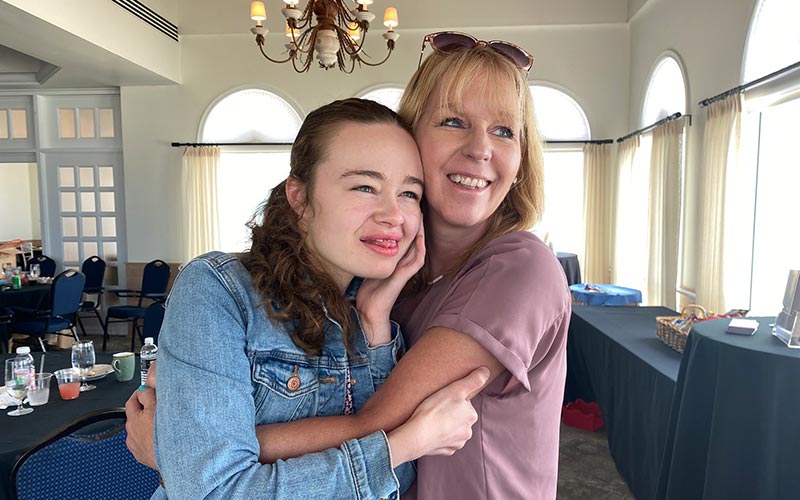Neurologists at NewYork-Presbyterian/
Their latest research, published in the journal Genes, links some Rett-like clinical features, such as abnormal hand movements, to the X-linked RNA-binding protein HNRNPH2 (heterogeneous nuclear ribonucleoprotein H2), a genetic variant first identified by Jennifer M. Bain, MD, PhD, a child neurologist at NewYork-Presbyterian/
“We proposed that this was a Rett-like gene, and therefore should be included in other genetic testing panels for when doctors see patients with regression and developmental delay,” says Dr. Bain.
We proposed that this was a Rett-like gene, and therefore should be included in other genetic testing panels for when doctors see patients with regression and developmental delay.
— Dr. Jennifer M. Bain
Understanding the genetics behind Rett Syndrome
Rett Syndrome, which was first described in 1966, is a progressive neurodevelopmental disorder typically diagnosed in early childhood. It is marked by a regression of developmental and motor skills followed by stabilization, hand abnormalities, gait abnormalities, language problems, and autistic features. The condition can be challenging to diagnose since it is heterogeneous and has overlapping features with other neurodevelopmental disorders, such as autism.
It wasn’t until 1999 that a causative gene – MECP2 – was identified. However, MECP2 is estimated to be present in about 95%-97% of individuals who meet clinical criteria for typical Rett Syndrome and only about 50%-70% of individuals with a diagnosis of atypical Rett Syndrome. Since then, CDKL5 and FOXG1 have also been linked to Rett phenotypes.
“MECP2 was the first one and is the most common cause of Rett. But there are all these other non-MECP2 genes that have been linked to a similar clinical picture for Rett disorder,” says Dr. Bain.
Dr. Bain identified HNRNPH2 as causative of neurodevelopmental disorder in 2016 and some individuals with the X-linked gene had a diagnosis of Rett Syndrome. In the latest study, Dr. Bain and colleagues surveyed individuals with a genetic confirmation of the presence of HNRNPH2 and their caregivers, and collected demographic information, including any diagnoses of Rett Syndrome.
“This was a paper to go back to those families who had already had a genetic diagnosis and to ask them, ‘what were the clinical pictures or diagnoses that they had gotten in the past.’ The goal of that was to say, ‘how can we identify more people in the community?’” says Dr. Bain.
The analysis included 26 completed patient surveys for 23 females and three males. Notably, 12 individuals met the clinical criteria for a diagnosis of Rett Syndrome but only three individuals had previously been diagnosed with atypical Rett Syndrome. Additional findings include:
- 18 of the 26 respondents had at least two characteristics of the major criteria for Rett Syndrome diagnosis, the most common of which were hand or gait abnormalities.
- 25 of 26 respondents reported tone abnormalities, which is considered one of the supportive criteria for a Rett Syndrome diagnosis.
- 14 of 26 respondents reported experiencing seizures.
Taken together, the clinical picture created by the survey results suggests that HNRNPH2 can result in a Rett-like clinical phenotype, according to Dr. Bain and colleagues, who recommended that HNRNPH2-related neurodevelopmental disorder be part of the differential diagnosis when evaluating patients with Rett-like characteristics. They also proposed that HNRNPH2 be included in genetic testing panels for these patients.

Amber (left) was previously diagnosed with Rett Disorder but with a new genetic diagnosis of HNRNPH2-related neurodevelopmental disorder, this has opened her up to more targeted family supports in addition to emerging new precision medicine treatments.
“For Rett syndrome, they often have hand stereotypies or abnormal hand movements, and so when doctors see patients with these types of clinical pictures, they can think about HNRNPH2, along with other genetic testing,” Dr. Bain says.
For Rett syndrome, they often have hand stereotypies or abnormal hand movements, and so when doctors see patients with these types of clinical pictures, they can think about HNRNPH2, along with other genetic testing.
— Dr. Jennifer M. Bain
The importance of genetic testing in diagnosing neurodevelopmental disorders
Genetic testing has become a routine part of the workup for diagnosing neurodevelopmental disorders, along with brain MRI and electroencephalogram, allowing neurologists to identify the specific genetic factors that may be contributing to the patient’s clinical presentation, Dr. Bain explains.
A genetic diagnosis can help to select appropriate treatment for a patient or help in enrolling them in a clinical trial. It also has other benefits for patients and families in terms of communicating about their condition. “They often feel that they don’t fit into a nice clean box and that practitioners don’t necessarily know how to take care of them,” Dr. Bain says. “It also provides them a lot of mental health support and family support, navigating a complex care medical system.”
Dr. Bain is also working with the Yellow Brick Road Project, a patient advocacy group, on an ongoing natural history study that has so far identified more than 150 people internationally with HNRNPH2 and continues to follow their progress. Additionally, she is expanding that effort to include other HNRNPH2 genetic cousins and is partnering with physicians around the world on the work. Closer to home, Dr. Bain is working with colleagues in physical therapy, orthopedics, endocrinology, and rehabilitation medicine to examine the various clinical manifestations of HNRNPH2-related neurodevelopmental disorder.
“We’re really trying to make it a multidisciplinary care model here at NewYork-Presbyterian/




